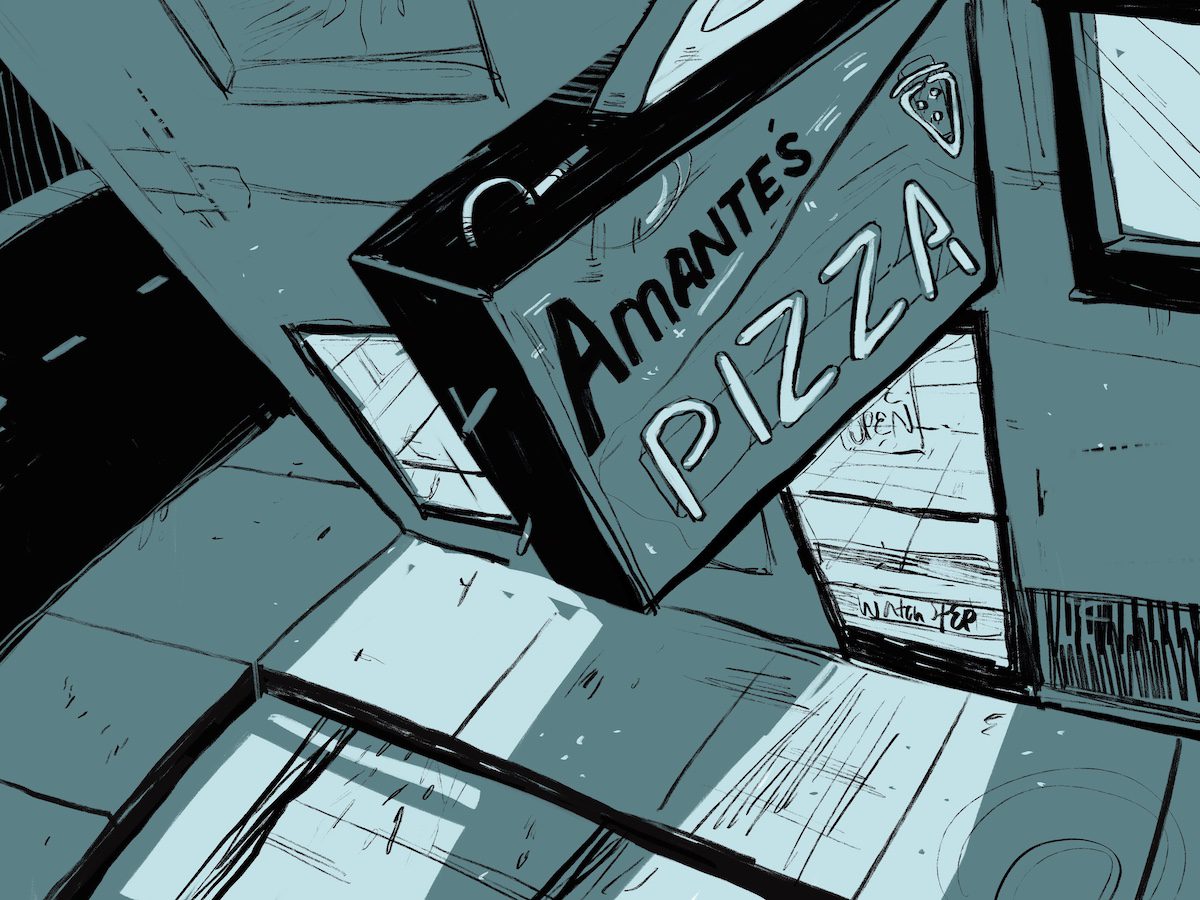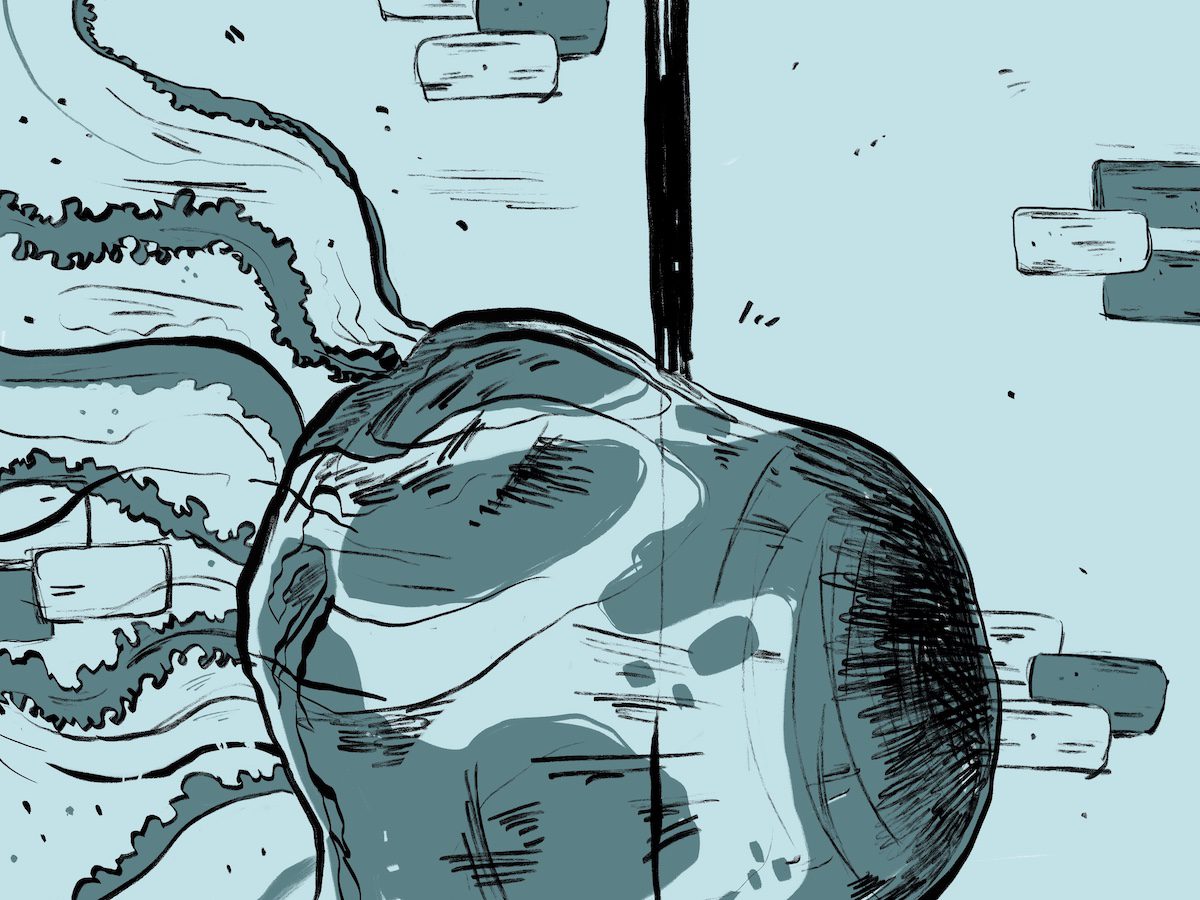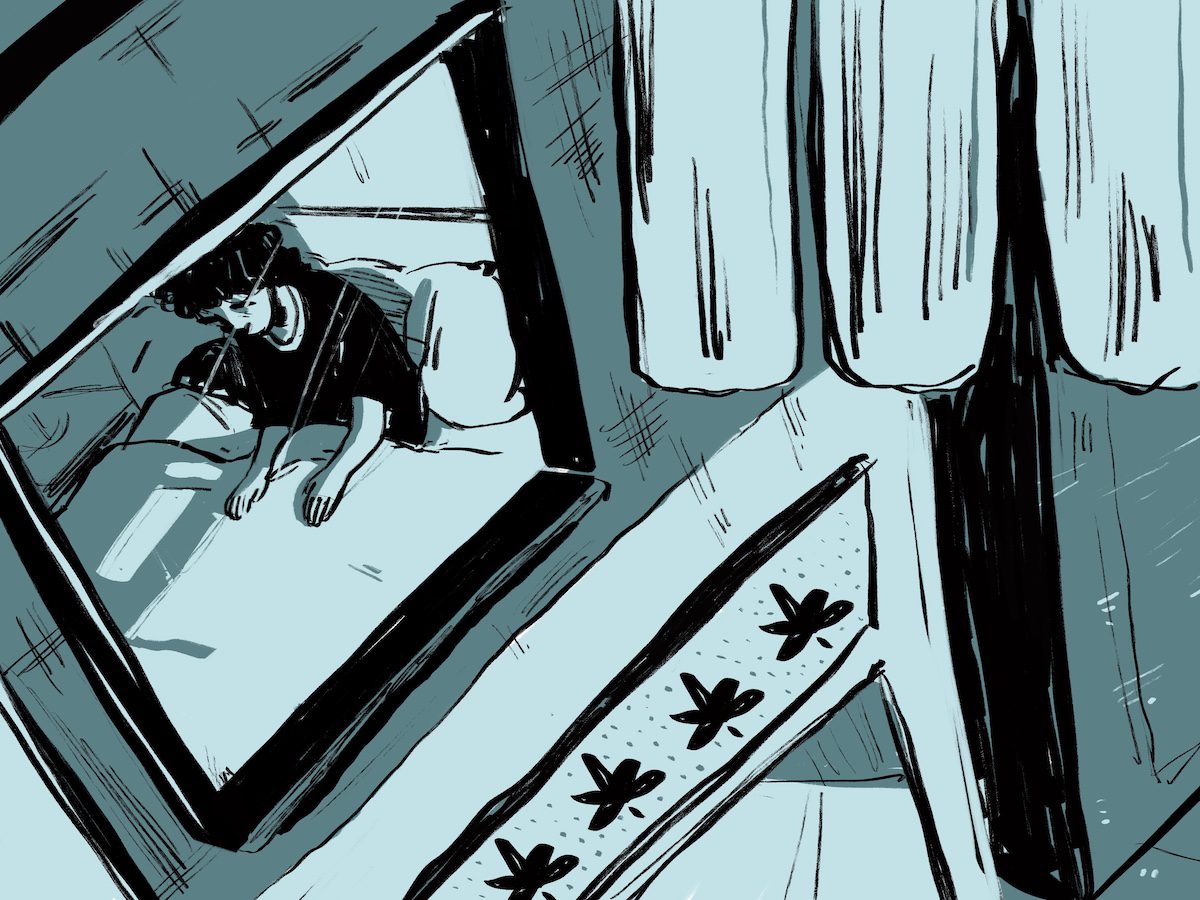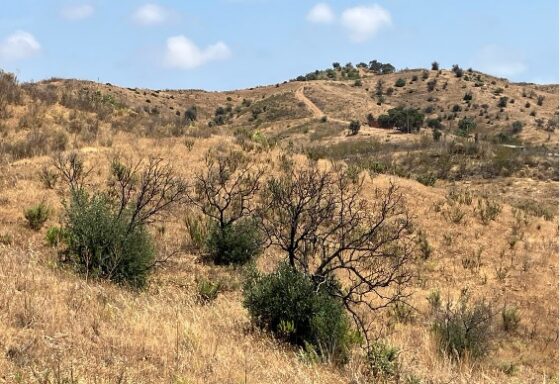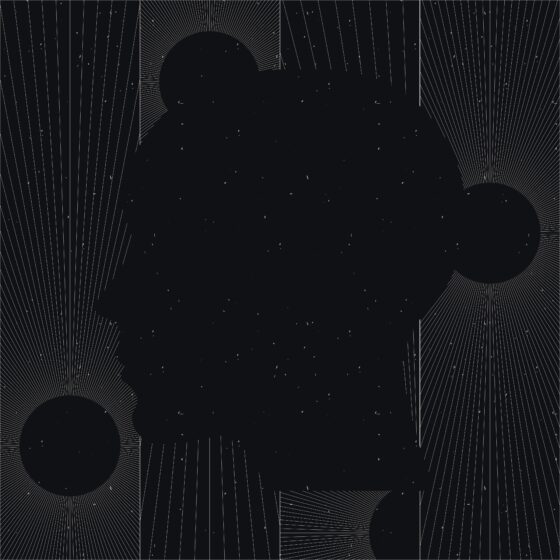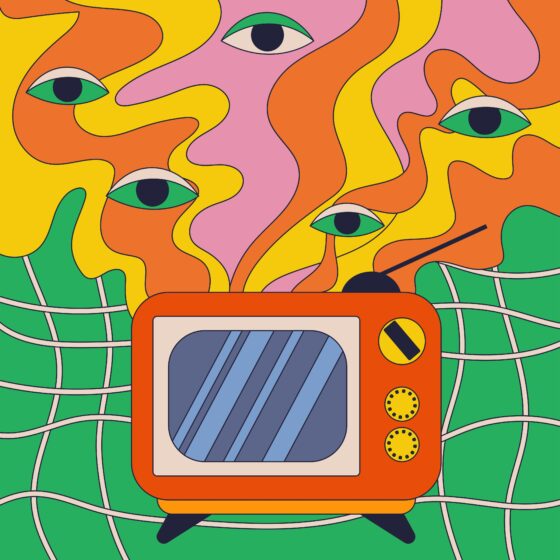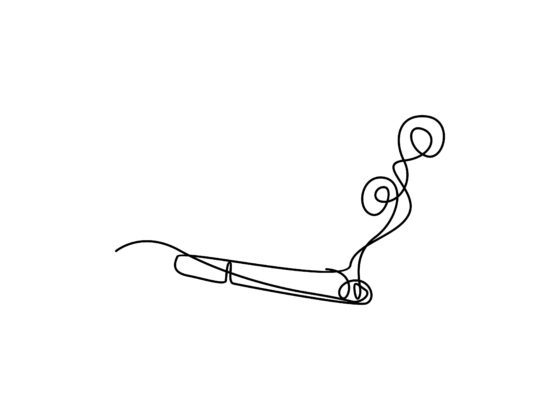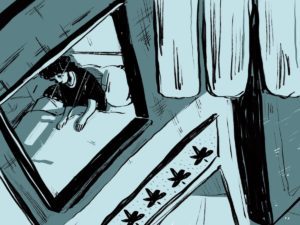
On a dark night last spring I discovered how accustomed I had grown to my nighttime view, drowned out by Amante’s pulsating pizza ad. Its vibrant hum syncopating with the corner’s streetlight: red:green, red:yellow, red:red, red:red, red:red.
Neon red bleeds into my bedroom window until one day it doesn’t. The LED sign, now unplugged and unlit, has been set leaning against the glossy red brick building like one of the coked-up frat bros who yell and howl and fistfight outside the late-night pizza joint, attracted to it like a drunken swarm of flies to a bloody carcass.
We return from an East Coast funeral on a red-eye flight. We wake two hours later to a drunk bro yelling homophobic slurs in the neighborhood where the crosswalks have been painted rainbow to honor gay pride. Clutching her glittering purse, a girl runs across the street toward him, her heels clicking with urgency, to tell him that he shouldn’t call people faggots. She doesn’t have time to scream before he punches her in the face and takes off running. She falls back, her head striking the concrete, both sides of her head now equally bludgeoned. She lies there motionless, her friend screaming and kissing her face. I dial 911, thinking of how I will describe the assailant to the dispatcher:
He is white.
He is wearing a black coat.
He is a man.
He is an asshole.
But these descriptors make half of the city’s population suspect.
I grab my shoes to go out and check whether the girl needs CPR just as flashing lights race across our apartment walls. I’m surprised by how quickly the ambulance arrives. One paramedic checks her vital signs as another rearranges her dress so that her panties are not visible to the growing crowd of concerned drag queens.
I don’t know it then, but paramedics were here only a few hours ago, as our plane was landing, to carry away my friend and neighbor who’d overdosed in his first-floor apartment. Before we left for our trip, he’d told us that he wanted to cook us dinner to celebrate our engagement. I told him that he was like my kid brother and to let us know if he needed anything. A few times I had found him stumbling near Captain’s and carried him home, his frail body weakly squeezing me close for stability. I wonder if I could’ve helped prevent his overdose had we not been away at another funeral. If we’d been home, his girlfriend would’ve run upstairs and I could have given him Narcan. But summer is the season of death. It’s the time of year when everyone I care about dies.
I gaze out at the new colors blossoming in the night’s darkness, at all that is now visible in the glaring light of the ambulance: The pizza place’s neon and LED signs set against the wall like a catafalque, the building’s windows papered over in preparation to unveil the new cannabis boutique designed by an acclaimed architecture firm.
A man walks his dog walks back and forth on the block a few times before looking left, looking right, and then pulling out a pocket knife to pry LEDs and wires loose from the idle sign. He pockets the items in between checking to his right and to his left. His dog is bored and paces on its leash. A cop pulls up to the curb and the man pets his dog; he looks up at the sky to pantomime that he is just a guy on a street corner, checking the weather and petting his dog. He is not a guy vandalizing a street corner with his dog posted as the unwilling lookout/decoy.
The color of the brick box changes over the summer from blood-red to seafoam greens and blues. The artist moves his ladder up and down the block to paint a mural of what looks at first like a red blood cell hanging over the new shop’s entrance, but within a week is transformed into a purple jellyfish emerging from the wall. I point at another mural he is working on now. “Is that Steve Zissou?” I ask.
“Kind of,” his arms bellow spray paint fumes as he sets down the rattling cans. “But who was Steve Zissou?” he smiles.
“Oh, Jacques Cousteau!” And I wonder whether Jacques Cousteau smoked BC bud when he sailed north through the San Juan islands.
The marijuana shop shimmers from the abyss, a glowing green jewelry box atop the hill. It is November now and the frequency of drunk tech bros getting into fights and yelling between 10 p.m. and 2 a.m. has decreased. Junkies still hawk drugs on the opposite street corner, their matinée meth ballet performances held daily across the street from legal, gentrified vices: small-batch IPAs and cannabis framed in glass displays.
The Emerald City’s prism catches the light. Depending on the weather, some days it casts a shade more akin to bile chartreuse than temperate rainforest. I still step over hypodermic needles on my way to work at the hospital. It’s 7 a.m. and I haven’t needed to help anyone having an overdose on our street in six months.
Since the COVID-19 quarantine began, all the neon signs hang unlit in the darkness. The karaoke bar’s muffled Journey ballads are silent and no one leans against its purple walls to smoke outside. Flirting, laughing, singing, dancing has ceased. Denny Way is no longer choked with rushing commuter traffic, homeless men weaving in between idling bumpers as they turn back to scream at a homeless woman following twenty steps behind. Her head down, she lumbers under the weight of two duffel bags slung in an X across her chest. Since the first death from COVID-19 in January, the homeless men still walk ahead of the homeless women but the streets are empty. The homelessness epidemic is alive and well during the pandemic.
At 3 a.m. I wake to hear a man screaming. I hold my breath, listening to the melody of his pain. Sometimes I tie my shoes and get dressed, go downstairs to see if I can help. But this time I decide to stay upstairs, when I hear the sharp and ringing sound of the man cursing as he beats a pipe against the apartments across the street.
In the morning, I eat cereal at our dining room table and look out at the city below. Without the constant drone of traffic I can hear the birds chirping on our roof above. I watch the rhythm of the empty cannabis shop’s phosphorescent glow syncopating with the streetlight: green:green, green:green, green:green.
***
Rumpus original art by Eva Azenaro Acero.
***
Voices on Addiction is a column devoted to true personal narratives of addiction, curated by Kelly Thompson, and authored by the spectrum of individuals affected by this illness. Through these essays, interviews, and book reviews we hope—in the words of Rebecca Solnit—to break the story by breaking the status quo of addiction: the shame, stigma, and hopelessness, and the lies and myths that surround it. Sisters, brothers, mothers, fathers, adult children, extended family members, spouses, friends, employers or employees, boyfriends, girlfriends, neighbors, victims of crimes, and those who’ve committed crimes as addicts, and the personnel who often serve them, nurses, doctors, social workers, therapists, prison guards, police officers, policy makers and, of course, addicts themselves: Voices on Addiction will feature your stories. Because the story of addiction impacts us all. It’s time we break it. Submit here.

